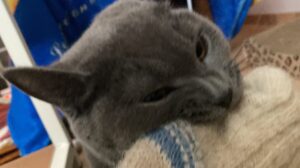Understanding Cat Zoomies: Normal or a Sign of Stress?
Ever wondered why your cat suddenly sprints around the house like a maniac? Discover what cat zoomies really mean—are they normal or a sign of stress?
What Are Cat Zoomies?
If you’re a cat owner, you’ve probably witnessed your feline friend suddenly darting across the room, leaping onto furniture, or running in circles for no apparent reason. These episodes are commonly known as “cat zoomies”, and while they can be amusing to watch, many pet parents wonder: Is this normal behavior, or could it indicate something more serious like stress or anxiety?
Cat zoomies, also referred to by veterinarians as Frenetic Random Activity Periods (FRAPs), are short bursts of high energy that result in spontaneous running, jumping, and playful antics. These episodes are most commonly observed in kittens and younger cats, but adult cats can experience them too. Zoomies usually last only a few minutes and often occur during specific times of the day—especially after a long nap, late at night, or following a visit to the litter box.
Why Do Cats Get the Zoomies?
There are several reasons why your cat might suddenly go into zoomie mode. Understanding these triggers can help you determine whether it’s a normal part of feline behavior or something that needs attention.
1. Pent-up Energy
Cats are natural hunters and athletes. In the wild, they would spend a significant portion of their day stalking, chasing, and pouncing on prey. Indoor cats, however, often lack the opportunity to expend that energy. Zoomies can be a way for your cat to release built-up energy, especially if they haven’t had enough playtime or stimulation during the day.
2. Post-Litter Box Relief
Some cats experience zoomies after using the litter box. This behavior is usually harmless and can be attributed to the feeling of relief or even a burst of excitement. However, if your cat frequently runs away from the litter box and also shows signs of discomfort or vocalization, it could indicate a medical issue like constipation or urinary tract infection.
3. Nighttime Instincts
Cats are crepuscular animals, meaning they are most active during dawn and dusk. If your cat gets the zoomies in the middle of the night, it’s likely due to their natural instincts kicking in—combined with the fact that they’ve likely been sleeping all day.
4. Stress or Anxiety
While zoomies are usually harmless, they can sometimes be a sign of stress or overstimulation. If your cat is experiencing changes in their environment—such as a recent move, new pet, or loud noises—they might react with sudden bursts of energy as a coping mechanism. In such cases, the zoomies may be accompanied by other signs of stress like hiding, excessive grooming, or reduced appetite.
Is It Normal or a Sign of Stress?
So, how can you tell if your cat’s zoomies are just a quirky part of their personality or a symptom of something deeper?
Normal Zoomies Indicators
- Happen occasionally (once or twice a day)
- Short duration (a few minutes)
- Occur after naps, meals, or litter box use
- Your cat seems happy and playful
Signs It May Be Stress-Related
- Zoomies happen excessively or at odd hours
- Accompanied by vocalization, hiding, or aggression
- Your cat avoids interaction or seems restless
- Changes in eating, grooming, or litter box habits
If you notice any of the stress-related behaviors, it might be time to evaluate your cat’s environment. Ask yourself:
- Has anything changed recently (new furniture, guests, other pets)?
- Is your cat getting enough playtime and stimulation?
- Are there enough hiding spots and vertical spaces for your cat to feel secure?
How to Manage and Reduce Zoomies
Whether your cat’s zoomies are normal or stress-induced, there are steps you can take to manage them effectively.
Tips to Handle Normal Zoomies
- Schedule daily play sessions with toys that mimic prey (like feather wands or laser pointers)
- Create a stimulating environment with scratching posts, cat trees, and puzzle feeders
- Stick to a routine—cats thrive on consistency in feeding, playtime, and sleep
If Zoomies Are Due to Stress
-
- Introduce changes gradually to reduce anxiety
- Use calming aids like pheromone diffusers or calming treats
- Provide safe spaces where your cat can retreat and feel secure
- Consult a vet or feline behaviorist if stress behaviors persist
*USB-Rechargeable 7-in-1 Laser Toy — aluminum body with pocket clip, quick slide selector, 5 fun patterns (dot, mouse, butterfly, smile, star) plus red/white/UV modes, and battery-free USB charging for instant play sessions.
*Sisal Cat Scratching Post (22″) — durable natural sisal, weighted MDF base with carpet cover for stability, neutral home-friendly look, and included plush toy to redirect zoomie energy away from your furniture.
*Comfort Zone Calming Pheromone Refills (6-Pack) — fragrance-free refills for Comfort Zone diffusers; designed to ease multi-cat tension and stress behaviors, each covering up to ~400 sq ft for ~30 days.
Conclusion: Embrace the Zoomies, But Stay Aware
In most cases, cat zoomies are a completely normal and healthy expression of feline energy and playfulness. They’re a sign that your cat is feeling good and has energy to burn. However, if zoomies become excessive or are accompanied by other unusual behaviors, they could be a sign of underlying stress or health issues.
Understanding your cat’s body language and behavior is key to ensuring their well-being. Keep an eye on patterns, provide plenty of enrichment, and don’t hesitate to seek professional advice if something feels off 🐾
